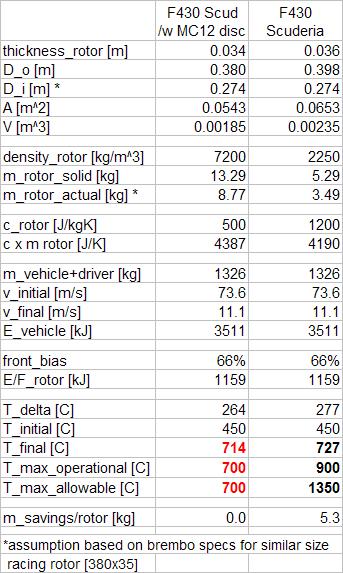Quote:
Originally Posted by swamp2

I heard the ZR1 uses rotors straight off the Enzo.
|
The ZR1 seems to be using the Enzo rotors, which are 380x34mm, in the rear wheels only. In the front, the ZR1 has 394mm rotors. I couldn't find thickness info though.
Quote:
Originally Posted by swamp2

Not the best estimate. That was for equivalent mass, not equivalent thermal mass. For equivalent thermal mass with the lower c you would need 2.5 thickness or a 22/19 diameter (or something in between). For the improved c you need a modest 1.5 thickness or a 15/12 diameter. Funny how the latter looks to be right about where things have gone, 15" OD and perhaps a bit thicker than "normal"!
|
Nope. That was not for equivalent mass. It was for equivalent heat capacity, which I assume is what you mean by "thermal mass". If we simply choose an equivalent heat capacity spec (4000 J/K seems to be a reasonable number although it doesn't matter what we pick as long as we use the same number for each case) and do the arithmetic on what it takes to provide that heat capacity based on the specs published for the different materials, we get what you see below:

As you can see, if one uses the currently available commercial Brembo CSiC rotor, one needs just 33% more volume to obtain the same thermal mass as an iron system. If the CSiC rotor referenced in the SGL SAE presentation exists, the difference is only 13%!
Now, back to your GT3 iron vs. CSiC rotor comparison. Let's shelve the relevance of conductivity and the temperature distribution, and use the lump sum thermal model you've been using. Let's also shelve where CSiC technology is going in the near-mid future, and look at what is available today for high-end production cars. I did a survey of rotor sizes in high-end performance cars, and the following are the largest rotor sizes I could find that are available today:
Iron: Maserati MC12; 380x34 mm
CSiC: F430 Scuderia; 398x36 mm (Brembo)
It turns out your assumption about the air gap being 1/3 of the total thickness and the total vent space resulting in 1/6 reduction in volume does not hold up. I went through the Brembo catalog for racing rotors and the air gap is more like 1/2 of the total thickness, and the reduction due to vents is more like 33% for a rotor of similar size 380x35 mm (see attachement for pdf page). This makes sense if you look at some pictures of the M3 rotors. Anyway, not that this should affect the iron vs CSiC comparison unless they have drastically different vent geometries, which I doubt is the case. (The carbon racing rotors do have a drastically different vent geometry though--they seem to have less vent spacing. Check them out on the Brembo website).
Anyway, using the 33% vent volume factor, I came up with a comparison. I stuck the largest available rotors of each kind in the F430 Scuderia. It obviously wouldn't have been fair to use the MC12 chassis as that is heavier than the Scuderia. If the Scuderia can accommodate the larger CSiC rotors, it can accommodate MC12's iron rotors as well, so this is an appropriate comparison. Here are the results:

The first thing to notice is that the two systems have comparable heat capacity--just above 4000 J/K--so the temperature increases experienced by the two systems should be comparable as well (again, we are not considering conductivity).
I am assuming that the pads can deliver peak CoF close to the respective peak operational temperatures of the two systems, and we have already agreed that that is not bad assumption. If we just run a 260kph to 50kph brake event with cold rotors, neither system will fade of course. Let's assume that we run the car through some tight parts of the track and seriously heat up the rotors without giving them a chance to cool down (we also agree that one can charge a rotor much faster than one can discharge it). Say they go up to 600C. Then let's say we accelerate to 265 kph and brake down to 50kph. Let's assume to rotors cooled down from 600C to 450C before the beginning of the braking event.
As expected, the lump sum thermal model predicts a similar temperature rise for each system, which puts the temperature toward the end of the braking event slightly over 700C for both systems. Now, the catch is that
this is well below the operational limits of the CSiC system, whereas the operational limit for the iron system has been exceeded.
Also, note that the CSiC rotor is still 5.3 kg lighter. It is possible to make it thicker for even higher thermal mass and lower temperatures while maintaining a weight advantage.